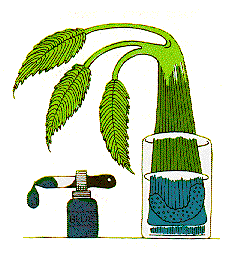CELERY STALKS AT MIDNIGHT Science Project for Kids 1/13/22
 CELERY STALKS AT MIDNIGHT
CELERY STALKS AT MIDNIGHT
Did you ever wonder how a paper towel can soak up a spill, or how water gets from a plant's roots to its leaves? The name for this is "capillary action."
What you'll need
4 same-size stalks of fresh celery with leaves
4 cups or glasses
Grown-up alert!
Red and blue food coloring
A measuring cup
4 paper towels
A vegetable peeler
A ruler
Some old newspapers
Your science journal
What to do
- Lay the 4 pieces of celery in a row on a cutting board or counter so that the place where the stalks and the leaves meet matches up.
- Cut all 4 stalks of celery 4 inches (about 10 centimeters) below where the stalks and leaves meet.
- Put the 4 stalks in 4 separate cups of purple water (use 10 drops of red and 10 drops of blue food color for each half cup of water).
- Label 4 paper towels in the following way: "2 hours," "4 hours," "6 hours," and "8 hours." (You may need newspapers under the towels).
- Every 2 hours from the time you put the celery into the cups, remove 1 of the stalks and put onto the correct towel. (Notice how long it takes for the leaves to start to change.)
- Each time you remove a stalk from the water, carefully peel the rounded part with a vegetable peeler to see how far up the stalk the purple water has traveled.
- What do you observe?
Notice how fast the water climbs the celery.
Does this change as time goes by? In what way? - Measure the distance it has traveled and record this amount in your science journal.
- Make a list of other objects around your house or in nature that enable liquids to climb by capillary action. Look for paper towels, sponges, old sweat socks, brown paper bags, and flowers.
Capillary action happens when water molecules are more attracted to the surface they travel along than to each other. In paper towels, the molecules move along tiny fibers. In plants, they move through narrow tubes that are actually called capillaries. Plants couldn't survive without capillaries because they use the water to make their food.
